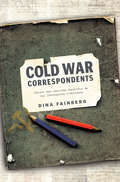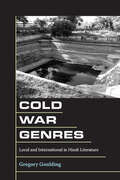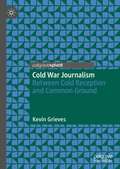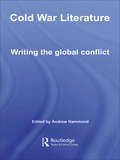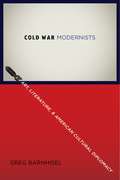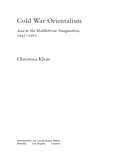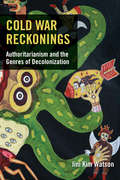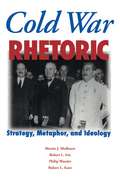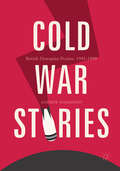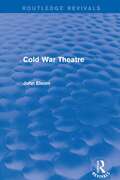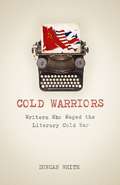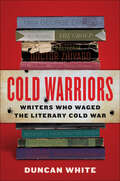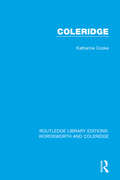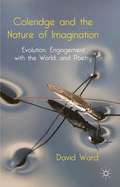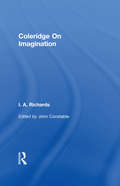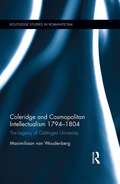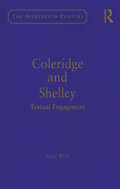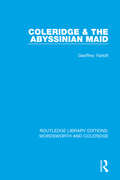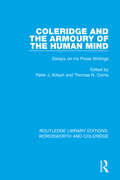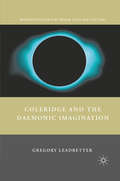- Table View
- List View
Cold War Correspondents: Soviet and American Reporters on the Ideological Frontlines
by Dina FainbergForeign correspondents played a crucial role in promoting the ideas and values of the Cold War. As they brought the foreign world to their Soviet and American readers, these journalists projected their own ideologies onto their reporting.In an age of mutual acrimony and closed borders, journalists were among the few individuals who crossed the Iron Curtain. Their reporting strongly influenced the ways that policy makers, pundits, and ordinary people came to understand the American or the Soviet "other." In Cold War Correspondents, Dina Fainberg examines how Soviet and American journalists covered the rival superpower and how two distinctive sets of truth systems, professional practices, and political cultures shaped international reporting.Fainberg explores private and public interactions among multiple groups that shaped coverage of the Cold War adversary, including journalists and their sources, editors, news media executives, government officials, diplomats, American pundits, Soviet censors, and audiences on both sides. Foreign correspondents, Fainberg argues, were keen analytical observers who aspired to understand their host country and probe its depths. At the same time, they were fundamentally shaped by their cultural and institutional backgrounds—to the point that their views of the rival superpower were refracted through values of their own culture. International reporting grounded and personalized the differences between the two nations, describing the other side in readily recognizable, self-referential terms. Fundamentally, Fainberg demonstrates, Americans and Soviets during the Cold War came to understand themselves through the creation of images of each other. Drawing on interviews with veteran journalists and Soviet dissidents, Cold War Correspondents also uses previously unexamined Soviet and US government records, newspaper and news agency archives, rare Soviet cartoons, and individual correspondents' personal papers, letters, diaries, books, and articles. Striking black-and-white photos depict foreign correspondents in action. Taken together, these sources illuminate a rich history of private and professional lives at the heart of the superpower conflict.
Cold War Genres: Local and International in Hindi Literature
by Gregory GouldingCold War Genres explores post-independence Hindi literature, framing it within the sociopolitical backdrop of Nehruvian India during the early Cold War. The book underscores the pivotal role of Hindi's claims to be a national language following independence, which fostered a unique moment of literary innovation. Central to its narrative is the work of Gajanan Madhav Muktibodh, a pivotal figure in modern South Asian literature. Using Muktibodh's poetry, criticism, and fiction as a primary example, the book shows how literary form shapes a response to the internal contradictions of 1950s India, one that must be read in light of both the antinomies of Hindi literature and North India as well as the aesthetic debates and emerging ideas of global space during this time. Cold War Genres therefore functions as a lens to evaluate questions of genre and form shared by a range of literary cultures in the mid-twentieth-century decolonizing world. This book features extensive translations from Muktibodh's poetry and prose, including full translations of two poems "Brahmarākṣas" (The Brahman Demon) and "Aṃdhere meṃ" (In the Dark).
Cold War Journalism: Between Cold Reception and Common Ground
by Kevin GrievesThis book explores Cold War journalism and journalists as threat, representing ‘enemy’ systems and ideologies. The book also examines Cold War aspirations of forging transnational journalistic connections across the Iron Curtain as well as finding common journalistic ground within the East and West blocs. The book shines a critical light on overly idealistic visions for that journalistic common ground, drawing on primary archival source material to investigate journalists and reporting work, journalistic content and journalistic venues during the Cold War era. This is not a book about traditional war correspondence – rather, it is about the rhetorical battles and the ideological fronts that have shaped and continue to shape our world. By fully understanding how journalism and journalists have intersected with hostile barriers and divisions in the past, we can have a more nuanced understanding of the current global media environment.
Cold War Literature: Writing the Global Conflict (Routledge Studies in Twentieth-Century Literature #Vol. 3)
by Andrew HammondThe Cold War was the longest conflict in a century defined by the scale and brutality of its conflicts. In the battle between the democratic West and the communist East there was barely a year in which the West was not organising, fighting or financing some foreign war. It was an engagement that resulted – in Korea, Guatemala, Nicaragua and elsewhere – in some twenty million dead. This collection of essays analyses the literary response to the coups, insurgencies and invasions that took place around the globe, and explores the various thematic and stylistic trends that Cold War hostilities engendered in world writing. Drawing together scholars of various cultural backgrounds, the volume focuses upon such themes as representation, nationalism, political resistance, globalisation and ideological scepticism. Eschewing the typical focus in Cold War scholarship on Western authors and genres, there is an emphasis on the literary voices that emerged from what are often considered the ‘peripheral’ regions of Cold War geo-politics. Ranging in focus from American postmodernism to Vietnamese poetry, from Cuban autobiography to Maoist theatre, and from African fiction to Soviet propaganda, this book will be of real interest to all those working in twentieth-century literary studies, cultural studies, history and politics.
Cold War Modernists
by Greg BarnhiselCold War Modernists documents how the CIA, the State Department, and private cultural diplomats transformed modernist art and literature into pro-Western propaganda during the first decade of the Cold War
Cold War Modernists: Art, Literature, and American Cultural Diplomacy
by Greg BarnhiselCold War Modernists documents how the CIA, the State Department, and private cultural diplomats transformed modernist art and literature into pro-Western propaganda during the first decade of the Cold War
Cold War Modernists: Art, Literature, and American Cultural Diplomacy
by Greg BarnhiselEuropean intellectuals of the 1950s dismissed American culture as nothing more than cowboy movies and the A-bomb. In response, American cultural diplomats tried to show that the United States had something to offer beyond military might and commercial exploitation. Through literary magazines, traveling art exhibits, touring musical shows, radio programs, book translations, and conferences, they deployed the revolutionary aesthetics of modernism to prove—particularly to the leftists whose Cold War loyalties they hoped to secure—that American art and literature were aesthetically rich and culturally significant. Yet by repurposing modernism, American diplomats and cultural authorities turned the avant-garde into the establishment. They remade the once revolutionary movement into a content-free collection of artistic techniques and styles suitable for middlebrow consumption. Cold War Modernists documents how the CIA, the State Department, and private cultural diplomats transformed modernist art and literature into pro-Western propaganda during the first decade of the Cold War. Drawing on interviews, previously unknown archival materials, and the stories of such figures and institutions as William Faulkner, Stephen Spender, Irving Kristol, James Laughlin, and Voice of America, Barnhisel reveals how the U.S. government reconfigured modernism as a trans-Atlantic movement, a joint endeavor between American and European artists, with profound implications for the art that followed and for the character of American identity.
Cold War Orientalism: Asia in the Middlebrow Imagination, 1945-1961
by Christina KleinIn the years following World War II, American writers and artists produced a steady stream of popular stories about Americans living, working, and traveling in Asia and the Pacific. Meanwhile the U.S., competing with the Soviet Union for global power, extended its reach into Asia to an unprecedented degree. This book reveals that these trends--the proliferation of Orientalist culture and the expansion of U.S. power--were linked in complex and surprising ways. While most cultural historians of the Cold War have focused on the culture of containment, Christina Klein reads the postwar period as one of international economic and political integration--a distinct chapter in the process of U.S.-led globalization. Through her analysis of a wide range of texts and cultural phenomena--including Rodgers and Hammerstein's South Pacific and The King and I, James Michener's travel essays and novel Hawaii, and Eisenhower's People-to-People Program--Klein shows how U.S. policy makers, together with middlebrow artists, writers, and intellectuals, created a culture of global integration that represented the growth of U.S. power in Asia as the forging of emotionally satisfying bonds between Americans and Asians. Her book enlarges Edward Said's notion of Orientalism in order to bring to light a cultural narrative about both domestic and international integration that still resonates today.
Cold War Reckonings: Authoritarianism and the Genres of Decolonization
by Jini Kim WatsonHow did the Cold War shape culture and political power in decolonizing countries and give rise to authoritarian regimes in the so-called free world? Cold War Reckonings tells a new story about the Cold War and the global shift from colonialism to independent nation-states. Assembling a body of transpacific cultural works that speak to this historical conjuncture, Jini Kim Watson reveals autocracy to be not a deficient form of liberal democracy, but rather the result of Cold War entanglements with decolonization.Focusing on East and Southeast Asia, the book scrutinizes cultural texts ranging from dissident poetry, fiction, and writers’ conference proceedings of the Cold War period, to more recent literature, graphic novels, and films that retrospectively look back to these decades with a critical eye. Paying particular attention to anti-communist repression and state infrastructures of violence, the book provides a richaccount of several U.S.–allied Cold War regimes in the Asia Pacific, including the South Korean military dictatorship, Marcos’ rule in the Philippines, illiberal Singapore under Lee Kuan Yew, and Suharto’s Indonesia. Watson’s book argues that the cultural forms and narrative techniques that emerged from the Cold War-decolonizing matrix offer new ways of comprehending these histories and connecting them to our present. The book advances our understanding of the global reverberations of the Cold War and its enduring influence on cultural and political formations in the Asia Pacific.Cold War Reckonings is available from the publisher on an open-access basis.
Cold War Rhetoric: Strategy, Metaphor, and Ideology
by Martin J. MedhurstNow available in paperback, Cold War Rhetoric is the first book in twenty years to bring a sustained rhetorical critique to bear on central texts of the Cold War. The rhetorical texts that are the subject of this book include speeches by Presidents Eisenhower and Kennedy, the Murrow-McCarthy confrontation on CBS, the speeches and writings of peace advocates, and the recurring theme of unAmericanism as it has been expressed in various media throughout the Cold War years. Each of the authors brings to his texts a particular approach to rhetorical criticism -- strategic, metaphorical, or ideological. Each provides an introductory chapter on methodology that explains the assumptions and strengths of their particular approach.
Cold War Stories: British Dystopian Fiction, 1945-1990
by Andrew HammondThis book is the first comprehensive study of mainstream British dystopian fiction and the Cold War. Drawing on over 200 novels and collections of short stories, the monograph explores the ways in which dystopian texts charted the lived experiences of the period, offering an extended analysis of authors' concerns about the geopolitical present and anxieties about the national future. Amongst the topics addressed are the processes of Cold War (autocracy, militarism, propaganda, intelligence, nuclear technologies), the decline of Britain's standing in global politics and the reduced status of intellectual culture in Cold War Britain. Although the focus is on dystopianism in the work of mainstream authors, including George Orwell, Doris Lessing, J. G. Ballard, Angela Carter and Anthony Burgess, a number of science-fiction novels are also discussed, making the book relevant to a wide range of researchers and students of twentieth-century British literature.
Cold War Theatre (Routledge Revivals)
by John ElsomCold War Theatre, first published in 1992, provides an account of the theatrical history within the context of East/West politics. Its geographical span ranges from beyond the Urals to the Pacific Coast of the US, and asks whether the Cold War confrontation was not in part due to the cultural climate of Europe. Taking the McCarthy era as its starting point, this readable history considers the impact of the Cold War upon the major dramatic movements of our time, East and West. The author poses the question as to whether European habits of mind, fostered by their cultures, may not have contributed to the political stalemates of the Cold War. A wide range of actors from both the theatrical and political stages are discussed, and their contributions to the theatre of the Cold War examined in a hugely enjoyable and enlightening narrative. This book is ideal for theatre studies students.
Cold Warriors: Writers Who Waged the Literary Cold War
by Duncan White'White handles hefty quantities of research effortlessly, combining multiple biographies with a broader overview of the period. His energetic, anecdote-laden prose will have you hooked all the way from Orwell to le Carré' Sunday Times, Books of the Year'Cold Warriors reads like a thriller . . . ambitious, intelligent, searching history' The TimesIn this age of 24-hour news coverage, where rallying cries are made on Twitter and wars are waged in cyberspace as much as on the ground, the idea of a novel as a weapon that can wield any power feels almost preposterous. The Cold War was a time when destruction was merely the press of a button away, but when the real battle between East and West was over the minds and hearts of their people. In this arena the pen really was mightier than the sword. This is a gripping, richly-populated history of spies and journalists, protest and propaganda, idealism and betrayal. And it is the story of how literature changed the course of the Cold War just as much as how Cold War would change the course of literature. Using hitherto classified security files and new archival research White explores the ways in which authors were harnessed by both East and West to impose maximum damage on the opposition; how writers played a pivotal role (sometimes consciously, often not) in the conflict; and how literature became something that was worth fighting and dying for. With a cast that includes George Orwell, Arthur Koestler, Graham Greene, Boris Pasternak, Andrei Sinyavsky, Mary McCarthy and John le Carré, and taking the reader from Spain to America to England and to Russia, this is narrative history at its most enthralling and most pertinent - pertinent because even if on the face of it there is a huge difference between 140 characters and 100,000 words, at the heart of both is the power of stories to change the fate of nations.
Cold Warriors: Writers Who Waged the Literary Cold War
by Duncan WhiteIn this brilliant account of the literary war within the Cold War, novelists and poets become embroiled in a dangerous game of betrayal, espionage, and conspiracy at the heart of the vicious conflict fought between the Soviet Union and the WestDuring the Cold War, literature was both sword and noose. Novels, essays, and poems could win the hearts and minds of those caught between the competing creeds of capitalism and communism. They could also lead to blacklisting, exile, imprisonment, or execution for their authors if they offended those in power. The clandestine intelligence services of the United States, Britain, and the Soviet Union recruited secret agents and established vast propaganda networks devoted to literary warfare. But the battles were personal, too: friends turned on one another, lovers were split by political fissures, artists were undermined by inadvertent complicities. And while literary battles were fought in print, sometimes the pen was exchanged for a gun, the bookstore for the battlefield.In Cold Warriors, Duncan White vividly chronicles how this ferocious intellectual struggle was waged on both sides of the Iron Curtain. Among those involved were George Orwell, Stephen Spender, Mary McCarthy, Graham Greene, Aleksandr Solzhenitsyn, John le Carré, Anna Akhmatova, Richard Wright, Ernest Hemingway, Boris Pasternak, Gioconda Belli, and Václav Havel. Here, too, are the spies, government officials, military officers, publishers, politicians, and critics who helped turn words into weapons at a time when the stakes could not have been higher.Drawing upon years of archival research and the latest declassified intelligence, Cold Warriors is both a gripping saga of prose and politics, and a welcome reminder that--at a moment when ignorance is all too frequently celebrated and reading is seen as increasingly irrelevant--writers and books can change the world.
Coleridge (RLE: Wordsworth and Coleridge #3)
by Katharine CookeFirst published in 1979, this book provides thorough a guide through Coleridge’s diverse body of work, looking not just his poetry but also his literary criticism and theories, plays, political journalism and theory, and writings on religion and philosophy. The author is careful to avoid emphasising one aspect of his work over another and consequently the whole emerges as a richer, more complete body of thought — less esoteric and more concerned with the world. It challenges the notion of the ‘damaged archangel’, showing he was a successful playwright, long-standing contributor to one of the foremost papers of the day and a literary figure of note in touch with leading thinkers and writers.
Coleridge And The Nature Of Imagination
by David WardExamining a range of Coleridge's writings, this book uses recent scientific research to understand how we have evolved to make mental representations of the counterfactual, how such transformative essays in Imagination have enabled humans to survive, to prosper and to express themselves in the sciences, the arts and particularly in poetry.
Coleridge On Imagination V 6
by John Constable I. A. RichardsIn the sixth volume of his Selected Works, I. A. Richards focuses on the writings of Samuel Taylor Coleridge.
Coleridge and Cosmopolitan Intellectualism 1794-1804: The Legacy of Göttingen University (Routledge Studies in Romanticism)
by Maximiliaan van WoudenbergViewing Samuel Taylor Coleridge's pursuit of continental intellectualism through the lens of cosmopolitanism, Maximiliaan van Woudenberg examines the so-called 'German Mania' of the writer in the context of the intellectual history of the university. At a time when the confessional model of Oxbridge precluded a liberal education in England, van Woudenberg argues, Coleridge's pursuit of continental methodologies and networks encountered at the University of Göttingen anticipated the foundation of the modern von Humboldt research-university model. Founded by the Hanoverian rulers of Great Britain, this cosmopolitan institution of knowledge successfully fostered cross-cultural interchange between German and British intellectuals during the latter half of the eighteenth century. van Woudenberg links the origins of Coleridge's engagement with European intellectualism to his first encounter with the innovations of a Reform university during his studies at the University of Göttingen in 1799, a period that many critics and biographers believe spoiled his poetry. Drawing on hitherto unexamined primary records and documents in German Kurrentschrift, this study shows Coleridge to be a visionary whose cross-cultural dissemination of continental intellectualism in England was ahead of its time and presents an intriguing episode in Cosmopolitan Romanticism by a major canonical figure.
Coleridge and Shelley: Textual Engagement (The\nineteenth Century Ser.)
by Sally WestSally West's timely study is the first book-length exploration of Coleridge's influence on Shelley's poetic development. Beginning with a discussion of Shelley's views on Coleridge as a man and as a poet, West argues that there is a direct correlation between Shelley's desire for political and social transformation and the way in which he appropriates the language, imagery, and forms of Coleridge, often transforming their original meaning through subtle readjustments of context and emphasis. While she situates her work in relation to recent concepts of literary influence, West is focused less on the psychology of the poets than on the poetry itself. She explores how elements such as the development of imagery and the choice of poetic form, often learnt from earlier poets, are intimately related to poetic purpose. Thus on one level, her book explores how the second-generation Romantic poets reacted to the beliefs and ideals of the first, while on another it addresses the larger question of how poets become poets, by returning the work of one writer to the literary context from which it developed. Her book is essential reading for specialists in the Romantic period and for scholars interested in theories of poetic influence.
Coleridge and the Abyssinian Maid (RLE: Wordsworth and Coleridge #14)
by Geoffrey YarlottFirst published in 1967, this book seeks to show the causes which led to Coleridge’s breakdown in 1802 and to indicate how his views on poetry changed as a result of it. The approach is selective in that it only focuses on one part of Coleridge’s life (roughly 1793-1810); however the author attempts to relate a number of different areas of his activity and to trace his emotional and moral development more closely than might be possible in a full-scale biography. The account of Coleridge’s life ends in 1810, when his relationship with the two key figures in his life Asra and Wordsworth had ruptured, as this reflected which of Coleridge’s Notebooks were available at the time.
Coleridge and the Armoury of the Human Mind: Essays on his Prose Writings (RLE: Wordsworth and Coleridge #7)
by Thomas N. Corns Peter J. KitsonFirst published in 1991, this book collects a broad array of path-finding scholarship by specialists in Coleridge and Romantic literature on the subject of his prose. They range from broad appraisals of Coleridge’s own critical practises; demonstrations of the fecundity of his autobiography, the Biographia Literaria, for contemporaries; the effect of Milton and the radical polemicists of the English Civil War on Coleridge’s early political and religious dissent; and the influence of the Hebrew prophetic tradition in his move away from the conjectural millenarianism of his youth towards the interpretation of Prophecy and a symbolic narrative.
Coleridge and the Daemonic Imagination (Nineteenth-Century Major Lives and Letters)
by Gregory LeadbetterThrough politics, religion and his relationship with Wordsworth, the book builds to a new interpretation of the poems where Coleridge's daemonic imagination produces its myths: The Ancient Mariner, Kubla Khan and Christabel . Re-reading the origins of Romanticism, Leadbetter reveals a Coleridge at once more familiar and more strange.
Coleridge and the Philosophy of Poetic Form
by Ewan James JonesEwan James Jones argues that Coleridge engaged most significantly with philosophy not through systematic argument, but in verse. Jones carries this argument through a series of sustained close readings, both of canonical texts such as Christabel and The Rime of the Ancient Mariner, and also of less familiar verse, such as Limbo. Such work shows that the essential elements of poetic expression - a poem's metre, rhythm, rhyme and other such formal features - enabled Coleridge to think in an original and distinctive manner, which his systematic philosophy impeded. Attentiveness to such formal features, which has for some time been overlooked in Coleridge scholarship, permits a rethinking of the relationship between eighteenth-century verse and philosophy more broadly, as it engages with issues including affect, materiality and self-identity. Coleridge's poetic thinking, Jones argues, both consolidates and radicalises the current literary critical rediscovery of form.
Coleridge and the Romantic Newspaper: The 'Morning Post' and the Road to 'Dejection'
by Heidi ThomsonThis book examines how Coleridge staged his private woes in the public space of the newspaper. It looks at his publications in the Morning Post, which first published one of his most famous poems, Dejection. An Ode. It reveals how he found a socially sanctioned public outlet for poetic disappointments and personal frustrations which he could not possibly articulate in any other way. Featuring fresh, contextual readings of established major poems; original readings of epigrams, sentimental ballads, and translations; analyses of political and human-interest stories, this book reveals the remarkable extent to which Coleridge used the public medium of the newspaper to divulge his complex and ambivalent private emotions about his marriage, his relationship with the Wordsworths and the Hutchinsons, and the effect of these dynamics on his own poetry and poetics.
